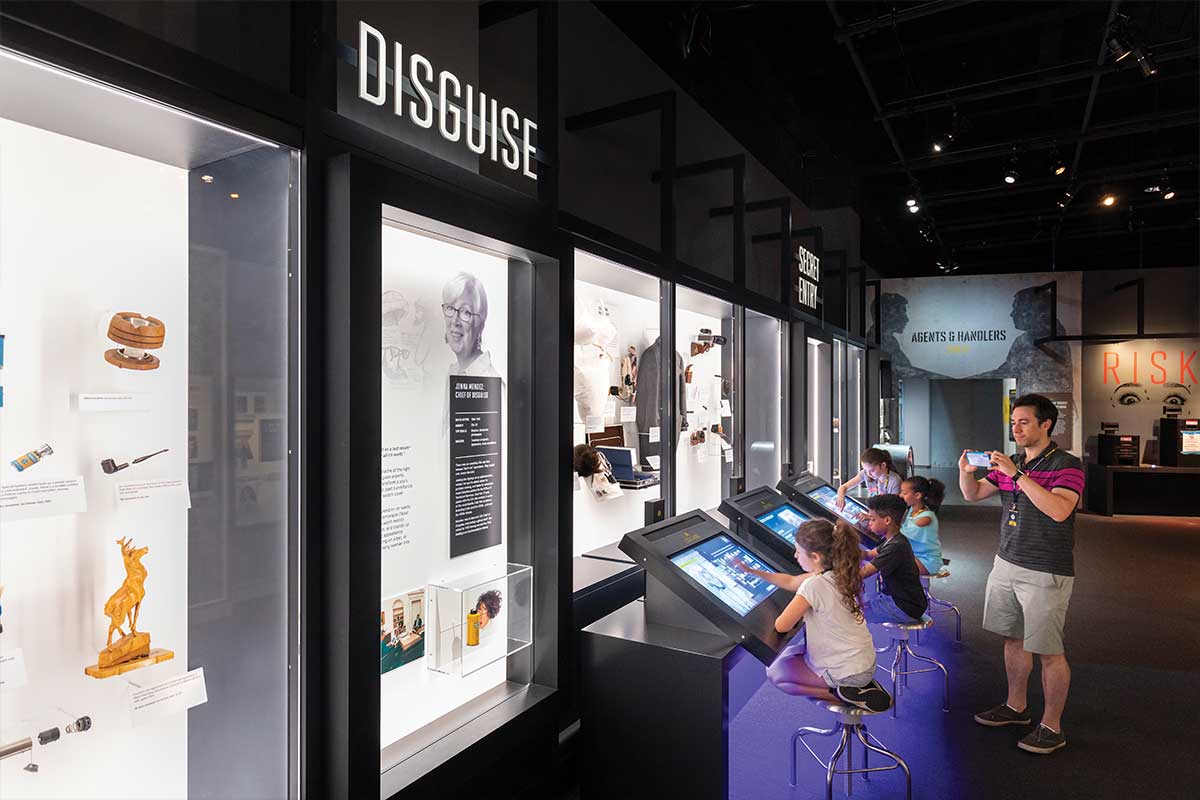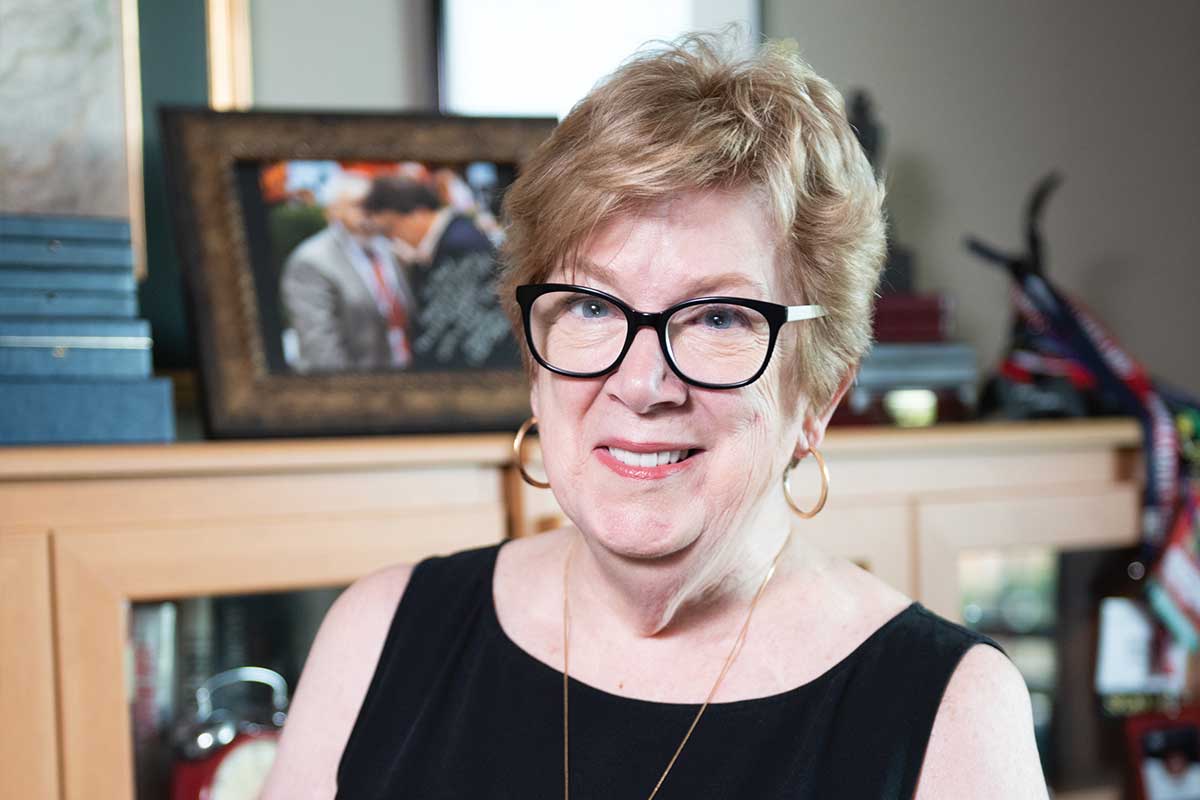The group gathered outside the Oval Office, preparing for the upcoming briefing with President George H.W. Bush. Jonna Mendez was nervous. She waited with national security advisers and top-level White House officials, who spoke collegially, laughing with one another. Mendez anxiously chewed on a pencil, pretending to study her notes, hoping no one would discover her secret. Her boss, CIA Director William Webster, who stood near her, had summoned her to the briefing. He was the only person she knew in the group.
The meeting began, and Mendez took the seat closest to the president. Authoritatively, the attractive 30-something-year-old with curly black hair discussed innovative disguise technology within the intelligence community.
“It’s a new generation mask,” Mendez said, indicating she was actually wearing the disguise. She offered to take it off, and Bush curiously leaned toward her for a closer look. Then he said, “OK, do it.” At that point, Mendez peeled off her strikingly lifelike mask, revealing her actual face and short red hair. She held up the mask that fooled the high-powered group. Bush, who had served as the CIA director in 1976, seemed impressed, and senior White House officials were taken aback. Decades later, Mendez received photos from the briefing where she’s showing her true face and holding her now-declassified mask.

“I love that picture,” she says.
A 27-year veteran of the U.S. intelligence community, Mendez unmasks the secrets of how she helped transform the CIA in her new memoir, titled In True Face, available early next year. Mendez, now 77, developed shockingly realistic methods for instantly changing appearances, carrying concealed cameras, and protecting operatives in the field. A number of her innovative disguises, like a pregnant-woman suit complete with secret camera, are on display at the International Spy Museum in Washington, DC.
“What I was good at, it turns out, was a little bit of leading, a little bit of showmanship, an ability to get people enthused to fund our programs to take the R&D forward and develop the next generations of masks,” she says. “And that’s why they made me chief of disguise.”
While completing her book at her home in Reston, Mendez considered the success she achieved during more than a quarter century in the clandestine community, ultimately serving as the department head overseeing the development of disguises worn by operatives and foreign assets. Mendez managed “technical wizards and operational specialists,” as she referred to her staff in her previous book, Spy Dust, authored with her late second husband, Antonio “Tony” Mendez, a CIA Trailblazer Award winner.
As chief of disguise for America’s spy agency, Mendez prepped foreign assets to operate subminiature spy cameras and processed intelligence gathered from them. At times, she was tasked with hiding the true identity of intelligence officers and foreign assets by creating false documentation and disguises at a moment’s notice.
Mendez says she faced internal barriers from time to time in the male-dominated field of intelligence. She says one of her male bosses disliked her and sabotaged her preparation for an important overseas mission.
“He was always trying to get me fired on that particular assignment,” she recalls. “He told me [the mission] was all about photography — I took all my photo stuff, but it wasn’t about photos — it was about disguise.”
The mission was deemed a “smoking-bolt” operation, where the CIA team, of which Mendez was a part, would extract a highly protected, top-secret Soviet communication device. The name “smoking bolt” alluded to the operation’s theft aspect: The only thing left would be the smoking bolts where the device had been fastened down.
For her part, Mendez would disguise the group, along with an indigenous man helping the CIA. She arrived unprepared, having brought none of her usual equipment. After gathering all the CIA agents in the office, she asked them to quickly bring her their wives’ makeup, which she used to hide the local asset’s identity. Mendez also sifted through rudimentary disguise kits in the office and found an unusual product for the operation.
“This [local] man had black hair,” she says. “I taped the can up so he couldn’t see that it was Dr. Scholl’s foot powder — that’s all I had — I combed it into his hair, and his hair turned wonderfully gray … and it worked,” she says.
That can of Dr. Scholl’s foot powder is now on display at the International Spy Museum.

Not only did Mendez disguise the asset, but she also created credible false documentation after photographing his new look. She knew the man’s credentials, not his face, would undergo the most scrutiny, so the ID had to be the perfect balance of authentic, worn, dirty, and blurred to be believable.
In Spy Dust, Mendez wrote: “It had taken me most of the night to produce the smudged and abraded identity document. The real problem had been finding fresh photo chemicals in this little off-the-beaten-path wreck of a Third World city.” To make the card look realistic and weathered, she wrote, she poured hot coffee on it, laid it on the garage floor, and rubbed it on the cement with her shoe.
In the end, Mendez says, “The operation was successful, and it was a big, big deal.”
Always in pursuit of the most convincing identities, Mendez and her team worked with renowned Hollywood makeup artists to create cutting-edge masks for believable disguises.
“I peeled my mask off long before Tom Cruise did,” she says with a smile, referring to the actor’s famous move in the Mission Impossible movies.
She also personally tested masks before subjecting operatives to using them. Committed to this process, she overcame stifling claustrophobia while undergoing face impressions for masks in an effort to understand what operatives go through.
“It was like being buried alive,” she says, recalling the complex, almost suffocating process of mask production. Mendez required everyone involved in mask-making to undergo the process themselves. When working with operatives, “You need to be able to say when you put on a mask, ‘I know what it feels like. I’ve done the same,’” she says.
Nothing about her upbringing hinted at her exciting future. Mendez was born in Kentucky, graduated from high school in Kansas, and attended Wichita State University. At age 20, she traveled to Germany for a friend’s wedding, fell in love with Bavaria, and stayed. Knowing no German, she settled in Frankfurt and looked for work by flipping through a phone book, alphabetically calling U.S. companies. She started with American Express and struck out, made a few more calls, and ultimately got hired by Chase Manhattan Bank. Eventually, she met and married her first husband, John Goeser, who informed her three days before the wedding that he worked for the CIA. In 1966, the CIA recruited her to work as a secretary.
Mendez outgrew the secretarial pool, though. She was bored and spent most of her time doing New York Times crossword puzzles in ink because she finished her work quickly. Recognizing her potential, management sent her to “the Farm” in Virginia — the CIA’s 9,000-acre covert training facility — where she learned the craft of espionage photography. She was assigned to the Office of Technical Operations in the 1970s, where she spent her illustrious career.
“When I joined the CIA, I liked being on the inside,” she says. “Inside felt like such a privilege. And I just loved that.”
Throughout her career, Mendez worked closely with the man who would eventually become her second husband. Tony Mendez was a renowned CIA officer who, most notably, helped rescue six U.S. diplomats from Iran in 1980 and was portrayed by Ben Affleck in the Academy Award-winning film Argo. At the height of the Cold War, this master spy duo matched wits with international intelligence agencies like the KGB in Moscow, Stasi in East Germany, and DGI in Cuba.
Tony and Jonna were instrumental in developing a series of innovative tactics — Hollywood-inspired identity swaps, ingenious evasion techniques, and an arsenal of brilliant gadgets — that allowed CIA officers to outmaneuver the KGB, according to their book The Moscow Rules.
Jonna helped identify KGB tactics on a harrowing trip to Cuba in 1988. Tony originally planned for Jonna to go to Moscow to collect data regarding the KGB’s surveillance modus operandi and suggest ways the CIA might counter it. However, the CIA’s chief of the Soviet and East European Division withheld her Moscow travel authorization, worried another operation could be compromised if she suddenly appeared on the scene.
With Jonna restricted from traveling to Moscow, it was decided that Cuba was the next best thing — the KGB trained the Cuban intelligence service extensively.
“We concluded that the Cubans were probably using Soviet tactics, and we could extrapolate one from the other,” Mendez says. For example, “Were there two rings of surveillance around our officers, one occasionally visible and an outer ring, over the horizon, ready to move in and pounce when we thought we were free?”
In hopes of luring these “ghost teams” out, Mendez walked around Havana for several days, acting as a normal tourist might. She visited Hemingway’s house, Finca Vigía, outside of the city. As expected, she saw discreet DGI surveillance of her movements. One afternoon, during the heat of the day, Mendez found herself alone on the street. Or was she? She sat on a shady bench in a plaza, intently studying a tourist map, her heart pounding. Was there a ghost team?
“There was a small movement in my peripheral vision,” she says. “I saw a young man on a bike, pedaling across the plaza. The man was barefoot and in khaki shorts and a T-shirt. He cut diagonally across the plaza, and then started moving away.”
Suddenly, she recalls, there was a loud clatter. As Mendez looked up, she saw what appeared to be a walkie-talkie radio with a remote earpiece attached by a long wire. The young man jumped down and scooped everything up, stuffed it all inside his shirt and sped away. His unintended gaffe of dropping his surveillance equipment confirmed the CIA’s suspicions of backup surveillance.
“The ghost team — just like in Moscow,” she says. “Just as we had predicted. We stored this away for future use.” The confirmation of KGB protocols proved helpful in later CIA operations in Moscow.
Amongst her colleagues in the CIA, one thing that didn’t stay secret was Mendez’s work ethic.
“Jonna Mendez’s soft-spoken, unassuming nature masks wit, determination, and leadership that made her a trailblazer for women in intelligence,” says former CIA operative Melissa Mahle, who was supported by Mendez in the field. “She broke down barriers in the male-dominated culture of the CIA not by declaring she was better at her job than most — which she was — or by demanding equal opportunity — which she did not have — but by quietly demonstrating over her career that she was the go-to professional that you wanted on your team. Jonna was an intelligence official first, who just happened to be female, which created pathways for other women to have greater opportunities based on merit.”
At the twilight of her intelligence career, Jonna married Tony in 1991, and she traded her chief of disguise job for a new role, as mother to their newborn baby, Jesse. Over the years, the couple, both retired from the intelligence field, teamed up to author several books chronicling their spellbinding experiences in the CIA. Tony, who had Parkinson’s disease, died in 2019.
Today, Mendez serves on the board of the International Spy Museum, where she speaks often. She is frequently interviewed by media outlets and hopes her new book will help her be remembered as a strong proponent of the intelligence community.
Amanda Ohlke, a director at the museum, summed up Mendez’s legacy: “She paved the way for so many women after her. A remarkable career — a national treasure.”
“That was my identity,” Mendez says. “If you’re going to spend your life doing something, why not make it something that matters? Because of the CIA and our sources of information, history was changed.”
This story originally ran in our July issue. For more stories like this, subscribe to our monthly magazine.





